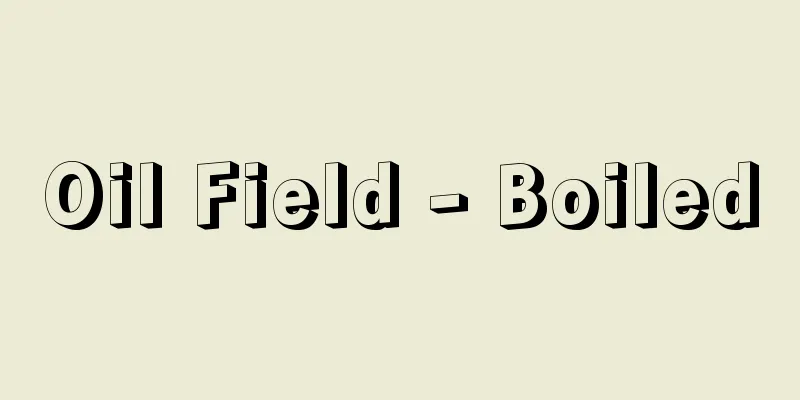Oil Field - Boiled

|
The name of the area where crude oil is extracted from underground. Oil fields are often named after the place where they are located, such as the oil field in Yabase, Akita City, called the Yabase Oil Field. Many offshore oil fields have been developed in the North Sea between the UK and Norway, and in addition to each individual oil field being named, the group of oil fields is collectively called the North Sea Oil Fields. In this way, a group of oil fields in one area can also be named collectively. [Shozo Tanaka] Oil field developmentPrior to oil field development, geological surveys and geophysical exploration are carried out. If the results suggest the possibility of the presence of an oil reservoir, an exploratory well is drilled. If the geological structure of the oil reservoir is an anticline, the exploratory well is drilled at the top of the anticline. If the exploratory well is successful and sufficient oil is produced, a borehole is drilled to investigate the extent of the oil field in order to determine the oil field's reserves. If the data indicates that there are sufficient reserves to warrant development, an oil field development plan is drawn up and full-scale development begins. When making a development plan, the first thing to consider is how many wells to drill for the development of an oil field. In the case of offshore oil fields, drilling one well is extremely expensive, so plans are made to extract enough oil from the entire field with the minimum number of wells. The basic idea behind determining the number of wells is that each oil well has its own unique oil-gathering area. Although it is impossible to determine from which part of the oil layer the oil that flows into an oil well comes, the idea is that the oil does not come from the entire oil layer, but from a certain limited part of the oil layer centered on that oil well, that is, from the oil-gathering area. In cases where the oil layer rock has good permeability, such as in the large oil fields of the Middle East, the area of the oil-gathering area is thought to be large, so a large amount of oil can be extracted from the entire oil field even with a small number of wells. For this reason, in large oil fields in the Middle East, wells are often spaced as far apart as one mile (1,600 meters). In oil fields where the oil reservoir rock has low permeability, the area of the oil collecting zone for each well is small, so the well intervals are about 200 meters, and many wells are drilled. Therefore, it is not the case that large oil fields have many oil wells and small and medium-sized oil fields have few oil wells; the opposite is often the case. [Shozo Tanaka] Oil field reservesThe basis of oil field development is the reserves of the oil field. Reserves are also called mineral reserves. Reserves can be classified from various perspectives. First, they are divided into total reserves and recoverable reserves. Not all of the oil in an oil reservoir can be extracted to the surface. The total amount of crude oil in an oil reservoir is called total reserves, and the amount of crude oil that can be extracted to the surface is called recoverable reserves. When talking about the amount of reserves in an oil reservoir, the recoverable reserves are referred to. The ratio of recoverable reserves to total reserves is called the recovery rate. The average recovery rate of an oil reservoir is said to be 25% to 30%. Even if an oil field is discovered, only a portion of the oil there is extracted, and more than 70% of the total reserves remain underground. Secondary and tertiary recovery are carried out to extract this remaining oil. As oil extraction technology advances and the recovery rate increases, the reserves of an oil field will increase. Reserves are further classified into proven, probable and possible. Proved reserves are the reserves determined after drilling wells and confirming the presence of oil in the strata. Probable reserves are the reserves of crude oil in the area where the presence of oil has been confirmed and where it is estimated from a geological perspective that oil is likely to be present. Possible reserves are the reserves in the area where the presence of oil has not yet been confirmed but where the presence of oil is geologically possible. When an exploratory well is successful, the proven and probable reserves of the oil field are calculated, but as the number of wells increases with the progress of oil field development, what was previously considered to be probable reserves will be included in the proven reserves. The history of oil mining is always a history of the expansion of exploration into areas where oil does not produce any. When an exploratory well is successful in an area where the presence of oil is geologically possible, the probable reserves will be rewritten as proven reserves. Since the oil produced from oil fields is not replenished, the total amount of oil reserves decreases, but the amount of oil whose existence has been confirmed, i.e., proven reserves, does not decrease or sometimes even increases, despite the consumption of oil. From the 1940s to the 1950s, oil reserves increased rapidly, ushering in the age of oil, but since the 1970s, oil reserves have remained flat. [Shozo Tanaka] R/P and oil lifeA common question is how many years oil has left, or how many years the lifespan of oil resources is. This is a difficult question, and perhaps no one has a correct answer. However, R/P is sometimes used as a guideline when considering this question. R means oil reserves, and P means annual production. If you think of an oil reservoir as a warehouse for oil, R is the amount in stock and P is the amount shipped, so R/P can be said to be the number of years until the oil in the warehouse runs out. For example, R/P in 1976 was 30 years, and this value can also be interpreted as meaning that the world's oil will run out in 30 years. However, since R/P is calculated by dividing oil reserves by production, if production doubles, R/P will be halved, and if production halves, the value will double. Therefore, the R/P figure is not an absolute value. Even if the R/P is 30 years, it is technically impossible for there to be not a single drop of oil left in 30 years, and as explained before, proven reserves may remain constant or even increase regardless of oil production, so it is clear that the R/P does not represent the lifespan of oil. Even if the R/P was 30 years in 1976, it may still be 30 years 30 years from now. As mentioned above, the R/P does not represent the lifespan of oil, but on the other hand, it can be said to show the finiteness of oil resources. The concept of R/P is sometimes used to estimate the lifespan of oil fields, and is useful as a guideline for oil field management. [Shozo Tanaka] Giant oil fieldIt is said that there are 20,000 to 30,000 oil fields in the world. The largest of these oil fields are the so-called giant oil fields. A giant oil field is one with reserves of more than 500 million barrels. A giant oil field with reserves of more than 5 billion barrels is called a super-giant oil field. The world's largest, the Ghawar oil field in Saudi Arabia, is a super-giant oil field with reserves of more than 60 billion barrels. Many of these giant oil fields are found in the Middle East, and they were discovered one after another from the 1940s to the 1950s, giving rise to the current oil age. It is said that there are about 250 giant oil fields and about 30 super-giant oil fields. The reserves of these approximately 300 oil fields account for 75% of the world's reserves. Many of Japan's crude oil imports come from Middle Eastern countries, and in 1981, imports from the Middle East accounted for about 69% of the total crude oil imports, showing the great influence of the giant oil fields in the Middle East. Whether or not oil reserves will increase in the future and whether or not we will be able to provide a stable supply of oil depends on the discovery of huge oil fields. [Shozo Tanaka] Global oil field developmentThe oil mining industry began with the success of the Drake Well in Pennsylvania, USA in 1859. The existence of oil had been known for a long time, but Drake was the first person to dig a well for the purpose of extracting oil. Oil mining spread to Texas and California in the USA, and many large and small oil fields were discovered. Oil fields are still being actively developed today, but the Prudhoe Bay Oil Field, discovered in 1968 on the North Slope within the Arctic Circle in Alaska, is a huge oil field that plays an important role in America's oil supply, but the Trans-Alaska Pipeline, which transports crude oil from this oil field, has attracted attention as to whether it should be for environmental conservation or oil resource development. Oil field development in Indonesia began as early as the 1870s, and the country continues to produce large quantities of crude oil today. The Minas oil field in Sumatra is the largest oil field in Southeast Asia, and also exports large quantities of crude oil to Japan. The Baku oil field facing the Caspian Sea was developed early on, and by the early 1900s Russia had become the world's number one oil-producing country. Oil fields in Western Siberia were developed in the 1960s, and the Samotlor oil field in the same region is one of the world's largest oil fields. The former Soviet Union region is still the world's largest oil-producing region today. Oil field development in the Middle East also began in the early 1900s, and following the discovery of the Masjed-e Soleyman oil field in Iran in 1908, oil field development progressed rapidly. The Ghawar oil field in Saudi Arabia and the Burgan oil field in Kuwait are among the world's largest oil fields, and the combined reserves of these two fields are said to account for 15% of the world's total oil reserves. Large oil fields were also discovered in North Africa, such as the Salil oil field in Libya and the Hassi Messaoud oil field in Algeria. In China, the Daqing oil field was discovered in the northeastern region in 1957, and since then, the Shengli oil field in Shandong Province, the Dagang oil field and the Renqiu oil field in Hebei Province, and others have been discovered. China has become a major oil producing country. Large oil fields were discovered one after another in the North Sea of Europe from the 1960s to the 1970s, and the UK has become an oil exporting country. In Mexico, the Reforma oil field is being developed in the southern state of Tabasco, and many other oil fields have been discovered, drawing attention to the future of the country's abundant oil resources. The discoveries of these huge oil fields ushered in the oil age, but it became difficult to meet the rapid growth in demand for oil, and the oil shock that followed the Yom Kippur War in 1973 led to calls for energy conservation. [Shozo Tanaka] Japanese Oil FieldsOil field development in Japan started early on, and in the Meiji era, Higashiyama, Nishiyama, and Niitsu oil fields were developed in Niigata Prefecture. In the Taisho era, Kurokawa and Toyokawa oil fields in Akita Prefecture were developed, and oil production increased dramatically. In the Showa era, Yabase oil field in Akita City was developed and became the largest oil field in Japan. In Hokkaido, Ishikari oil field near Sapporo City was developed early on. The history of oil mining in Japan began at roughly the same time as the history of oil mining in the world, but no large oil fields like those in the Middle East have been discovered, and currently there are only the Aganoki oil and gas field offshore Niigata City, the Minamiaga oil field and Kubiki oil and gas field on land in Niigata Prefecture, the Amarume oil field in Yamagata Prefecture, and the Sarukawa oil field and Yabase oil field in Akita Prefecture. Oil exploration is still ongoing, but more gas fields have been discovered than oil fields. [Shozo Tanaka] Overseas oil field development by Japanese oil development companiesAs oil development technology becomes more advanced, Japanese companies are developing oil fields in the Middle East and Indonesia to cooperate with oil-producing countries in their oil field development and to secure oil resources for Japan. In the Middle East, they are developing the Khafji oil field offshore between Saudi Arabia and Kuwait, the Zakum oil field offshore Abu Dhabi, the Umm Shaif oil field, the Mubarraz oil field, and the El Bunduq oil field. In Indonesia, oil is produced in the Attaka oil field, the Bekapay oil field, and the Handil oil field, and in Africa, the Baliste oil field offshore Gabon and the GCO oil field offshore the Democratic Republic of the Congo (formerly Zaire). They are also exploring for oil resources around the world, including in China's Bohai Bay and offshore Sakhalin. [Shozo Tanaka] [Reference] | | | | |Koshi District, Niigata Prefecture (present-day Nagaoka City). "Photographic Collection of Scenic Places and Historic Sites of Japan, Based on National Elementary School Textbooks, Heaven" (1912, Meiji 45), National Diet Library Higashiyama oil field (Meiji era) Source: Shogakukan Encyclopedia Nipponica About Encyclopedia Nipponica Information | Legend |
|
地下から原油を採収している地域の呼称。秋田市八橋(やばせ)にある油田を八橋油田とよぶように、油田が存在する地名で名前がつけられることが多い。またイギリスとノルウェーの間にある北海では、多くの海洋油田が開発されているが、個々の油田に名前がつけられているほかに、これら油田群を総称して北海油田とよんでいる。このように一つの地域にある油田群を総称して名前をつけることもある。 [田中正三] 油田の開発油田開発に先だって地質調査や物理探査が実施される。その結果油層の存在の可能性が推定されると試掘井が掘削される。油層の地質構造が背斜構造のときには、試掘井は背斜の頂部に掘られる。試掘井の掘削に成功し十分な石油の産出が確認されると、油田の埋蔵量を調べるため、油田の広がりを調査する坑井が掘られる。そのデータから開発に足る十分な埋蔵量があることがわかると、油田開発の計画がたてられ本格的な開発が始まる。 開発計画をたてるときまず考えることは、油田開発のため幾本の坑井を掘るかということである。海洋油田の場合など、1本の坑井を掘るのに莫大(ばくだい)な費用がかかるから、最少の坑井数で油田全体から十分な油を採収できるように計画がたてられる。坑井数を決める基本的な考え方は、各油井はそれぞれ特有な集油区域をもっているということである。1本の油井へ流入する油は、油層のどの部分から流れてくるかは明らかにすることはできないが、油層全体から集まってくるのではなく、その油井を中心とした一定の限定された油層部分から、すなわち集油区域から流入するという考え方である。中東の大油田のように油層岩石の浸透性がよい場合には、集油区域の面積は大きいと考えられるので、坑井数が少なくても油田全体から多量の油が採収できることになる。このため中東の大油田では各坑井の間隔は1マイル(1600メートル)という大きい間隔にとられることも多い。油層岩石の浸透性の小さい油田は、各油井の集油区域の面積が小さいから、坑井間隔は200メートル程度となり、数多くの坑井が掘られることになる。したがって、大油田は油井の数が多く、中小油田は油井の数が少ないというものでなく、その逆の場合が非常に多い。 [田中正三] 油田の埋蔵量油田開発の基礎となるのは油田の埋蔵量である。埋蔵量は鉱量ともいう。埋蔵量はいろいろの観点から分類できる。まず総埋蔵量と可採埋蔵量に分けられる。油層中にある油は全部地表へ採収できるものではない。油層中の原油の総量を総埋蔵量といい、地表へ採収できる原油の量を可採埋蔵量という。油層の埋蔵量はいくらあるかというときは可採埋蔵量をいう。可採埋蔵量と総埋蔵量の比を採収率という。油層の平均採収率は25%から30%といわれている。一つの油田が発見されても、そこにある油の一部が採収されるだけで、総埋蔵量の70%以上が地下に残留してしまう。この残留した油を採収するために、二次採収、三次採収が実施される。石油採収の技術が進み採収率が大きくなれば、油田の埋蔵量は増大することになる。 埋蔵量はまた確認埋蔵量、推定埋蔵量および予想埋蔵量に分類される。確認埋蔵量とは、坑井を掘り、地層中の油の存在を確認してから求められた埋蔵量である。推定埋蔵量は、油の存在が確認された地層において、地質学的にみて油が確実にあるだろうと推定された区域の原油の埋蔵量である。予想埋蔵量は、石油の確認はまだなくても、地質学的に石油の存在が考えられる地域の埋蔵量である。試掘井が成功すると、その油田の確認埋蔵量と推定埋蔵量が求められるが、油田開発の進展に伴い坑井数が増加をすると、いままで推定埋蔵量とされていたものが確認埋蔵量に算入されることになる。石油鉱業の歴史はつねに石油の産出しない地域への探査拡大の歴史である。石油の存在が地質学的にみて考えられる地域において、試掘井が成功すれば、予想埋蔵量が確認埋蔵量に書き換えられることになる。油田から産出し消費される石油は再生することはないから、石油の埋蔵量は全体としては減少していくが、その存在が確認された石油の量すなわち確認埋蔵量は、石油の消費にもかかわらず、減少しなかったり、ときとしては増加をすることさえもおこる。1940年代から50年代は石油埋蔵量が急激に増加し、石油の時代が出現したが、70年代になってからは石油埋蔵量は横ばいである。 [田中正三] R/Pと石油の寿命石油はあと何年もつか、石油資源の寿命はあと幾年かということがよく問題となる。この問題はむずかしい問題で、だれも正しい答えの出ない問題であるかもしれない。しかしこの問題を考えるときの目安としてR/Pが用いられることがある。Rは石油の埋蔵量を、Pは毎年の生産量を意味する。油層を油の倉庫と考えれば、Rは在庫量でPは出荷量であるから、R/Pは、倉庫にある石油がなくなるまでの年数ともいえる。たとえば1976年のR/Pは30年であったが、この値から世界の石油は30年後になくなってしまうとも解釈される。しかしR/Pは石油の埋蔵量を生産量で割るのであるから、生産量が倍になればR/Pは2分の1に、生産量が2分の1になれば、その値は倍になる。したがってR/Pの数字は絶対的な値ではない。R/Pが30年といっても、30年後に石油が一滴もなくなることは、技術的にありえないことであるし、前に説明したように確認埋蔵量は、石油の産出にかかわらず、一定の値を保つ可能性もあり、増加する可能性があるから、R/Pは石油の寿命を表すものでないことは明らかである。1976年の時点でR/Pが30年であっても、30年後依然としてR/Pが30年であることもありうることである。以上のようにR/Pは石油の寿命を表すものでないが、一面、石油資源の有限性を示すものであるとはいえる。油田の寿命についてもR/Pの考え方が用いられることがあり、油田管理上の一つの目安として役だっている。 [田中正三] 巨大油田世界中にある油田の数は2万とも3万ともいわれている。これら油田のうち大きな位置を占めているのが、巨大油田とよばれる大油田である。巨大油田は埋蔵量が5億バレル以上の油田である。巨大油田のうち埋蔵量が50億バレル以上の油田を超巨大油田という。世界最大のサウジアラビアのガワール油田は、埋蔵量が600億バレル以上といわれる超巨大油田である。これら巨大油田は中東に多く存在し、昭和20年代から30年代にかけて次々に発見され、現在の石油時代を出現させた。巨大油田の数は約250、超巨大油田の数は約30あるといわれている。これら約300の油田の埋蔵量は、世界の埋蔵量の75%を占めているという。日本の原油輸入先の国は中東の国々が多く、1981年では中東よりの輸入量は、全原油輸入量の約69%を占め、中東の巨大油田群の影響の大きさを示している。今後石油埋蔵量が増加し、安定した石油の供給ができるか否かは、巨大油田の発見にかかっている。 [田中正三] 世界の油田開発石油鉱業は1859年のアメリカ、ペンシルベニア州のドレーク井の成功より始まった。石油の存在は古くより知られていたが、石油採収を目的として井戸を掘ったのはドレークが最初の人である。石油鉱業はアメリカでテキサス州やカリフォルニア州に広がっていき、大小の油田が数多く発見された。現在でも油田が活発に開発されているが、1968年アラスカの北極圏内のノース・スロープで発見されたプルドー・ベイ油田は巨大油田で、アメリカの石油供給に重要な役割を果たしているが、同油田から原油を送るアラスカ縦断パイプラインは、自然保護か石油資源開発かをめぐって注目を集めた。 1870年代には早くもインドネシアの油田開発が始まり、現在も多量の原油を産出している。スマトラのミナス油田は東南アジア最大の油田で、日本へも多量の原油を輸出した。カスピ海に面したバクー油田は早くから開発され、1900年代の初めにはロシアは世界第一の産油国になった。1960年代には西シベリアの油田が開発され、同地域にあるサモトロール油田は世界屈指の大油田である。旧ソ連地域は現在も世界最大の産油地帯である。 中東の油田開発も1900年代初めより始まり、1908年イランのマスジェデ・ソレイマーン油田の発見より、油田開発は急速に進んでいった。サウジアラビアのガワール油田、クウェートのブルガン油田は世界最大級の油田で、両油田の埋蔵量合計は全世界の石油埋蔵量の15%ともいわれている。北アフリカでもリビアのサリル油田、アルジェリアのハッシ・メサウド油田などの大油田が発見された。中国では1957年東北地方で大慶油田が発見され、以後、山東省で勝利油田、河北省で大港油田、任邱油田などが発見された。中国は石油の大生産国となった。ヨーロッパの北海では1960年代から70年代にかけて次々に大油田が発見され、イギリスは石油の輸出国となった。メキシコは、南部のタバスコ州でレフォルマ油田が開発されており、そのほか多くの油田が発見され、豊富な石油資源の将来が注目されている。 このような大油田の発見により石油時代が到来したが、石油の需要の急速な伸びを満たすことが困難となり、1973年の第四次中東戦争のときの石油ショックから、省エネルギーが叫ばれるようになった。 [田中正三] 日本の油田日本の油田開発は早くより行われ、明治時代には新潟県で東山油田、西山油田、新津油田などの開発が行われている。大正時代になると秋田県の黒川油田、豊川(とよかわ)油田などが開発され、石油の生産量は飛躍的に増大した。昭和になると秋田市の八橋(やばせ)油田が開発され、日本最大の油田となった。北海道では札幌市の近くの石狩油田が早くより開発された。日本の石油鉱業の歴史は、世界の石油鉱業の歴史とほぼ同時代に始まったが、中東のような大油田の発見はなく、現在は新潟市沖合いにある阿賀(あが)沖油・ガス田、新潟県陸上部にある南阿賀油田、頸城(くびき)油・ガス田、山形県の余目(あまるめ)油田、秋田県の申川(さるかわ)油田、八橋油田などがあるにすぎない。現在も油田の探査が続けられているが、油田よりもガス田が多く発見されている。 [田中正三] 日本の石油開発企業の海外での油田開発石油開発技術は高度化しているため、産油国の油田開発への協力と日本の石油資源確保のため、日本企業は中東やインドネシアなどで油田開発を行っている。中東ではサウジアラビアとクウェートの中間の沖合いにあるカフジ油田、アブダビ沖のザクム油田、ウムシャイフ油田、ムバラス油田、エルブンドク油田の開発を行っている。インドネシアではアタカ油田、ブカパイ油田、ハンディル油田、アフリカではガボン沖合いのバリステ油田、コンゴ民主共和国(旧ザイール)沖合いのGCO油田などで石油を生産している。また中国の渤海(ぼっかい)湾、サハリン沖合いなど世界各地で石油資源の探査を進めている。 [田中正三] [参照項目] | | | | |新潟県古志郡(現在の長岡市)。『日本名勝旧蹟産業写真集 国定小学校教科書準拠 天』(1912年〈明治45〉)国立国会図書館所蔵"> 東山油田(明治時代) 出典 小学館 日本大百科全書(ニッポニカ)日本大百科全書(ニッポニカ)について 情報 | 凡例 |
Recommend
Foreign language education - gaikokugokyoiku (English)
A foreign language is a language that is not used ...
Pondaungia
...This period can be said to be the period of ad...
Flores, JJ
…After a series of internal conflicts, Colombia l...
Manor records - Shoenshiryo
Compiled by Shimizu Masatake (1856-1934). Born in ...
Pycreus sanguinolentus (English spelling) Pycreussanguinolentus
…[Tetsuo Koyama]. … *Some of the terminology that...
Kajiwara Kagetoki
A military commander in the early Kamakura period...
Shinwa [town] - Shinwa
A former town in Amakusa County, eastern Amakusa S...
Acute low back pain
...It often occurs when trying to lift something ...
Rallaria (Rallaria) - Rallaria (English spelling) mesite
A general term for birds in the Mesoenatidae famil...
Sakura Maruyama
Year of death: August 18, 1899 (Meiji 32) Year of ...
Nicholson, W. (Chemist)
… It can be said that the new development of elec...
Audio equipment - Audio listening
The basis of audio is to enjoy listening to sound,...
rugby
A type of ball game. Officially, it is called rugb...
Fruit drink - Kajitsuinryo
Beverages made from squeezed fruit juice. The Japa...
QWL - Quality of working life
Also known as quality of working life, this is a g...
![Rankoshi [town] - Rankoshi](/upload/images/67cd2270d99ce.webp)








